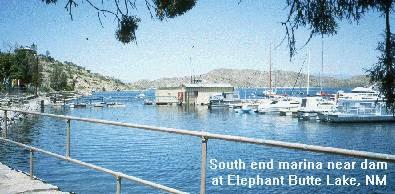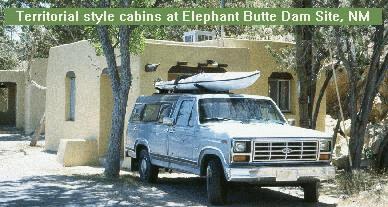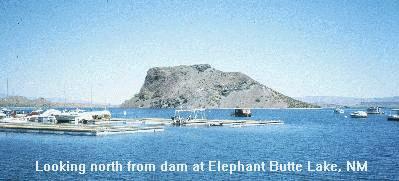 Paddling
Rio Grande Lakes
Paddling
Rio Grande Lakes Paddling
Rio Grande Lakes
Paddling
Rio Grande Lakesby Phil Rowe
The magnificent Rio Grande, from its headwaters in southern Colorado's high country to the estuary at the Gulf of Mexico, offers several great places for paddling. Some folks like the rough white water near Taos, New Mexico. Others prefer the calmer lakes formed by dams on the river in central New Mexico and along the Texas-Mexico border. I happen to like the lakes, especially Elephant Butte Lake and the smaller Cochiti Lake (closer to Santa Fe). Great canoe or touring kayak waters.
Waters of this important and historic river vary greatly in quality and quantity, largely according to the seasons. Spring brings snow melt in the high country the river flows fast and rough, picking up lots of silt and considerable debris from the shoreline. The waters become brown and murky and stay that way until the flow lessens later in the Summer. By Fall the waters are quite clear in many places, especially in lakes where silt can settle out. By winter the river is low and so are the lakes, often reduced to allow for the next Spring's runoff. It's a cyclical system.
One of my favorite places to paddle Rio Grande waters is Elephant Butte Lake. That's "beaut" and not "butt", dear reader, despite what some Texans have been known to say. Between Soccoro and Truth or Consequences ( the name of a town influenced by showman Ralph Edwards, but that's another story ), is the largest lake formed on the river before you get to Texas. The name comes from a mountain east of the river, a massive butte rising steeply and dominating the eastern skyline of the area. It's a man-made lake with a surprisingly unimpressive dam at the south end. Interstate highway I-25 parallels the river and the lake.

Elephant Butte Lake is the premier fishing and water sports center of central New Mexico. It's quite large, long and narrow, with a marinas and parks for public access, mostly on the western shore. Lodging, dining, camping and other facilities accommodate huge crowds, especially on holiday weekends. Though the surrounding hills and cliffs are generally stark and bare, denuded of trees and grasses by the desert dryness, there's a beauty to it that grows on you. Skies are typically so clear, sunny brilliant and blue, one must take precautions against sunburn and extended exposure. The Lake is over 4000 feet above sea level and the air is thin, affording less filtering of sunlight than at lower elevations.

A quaint and unique motel or cabin complex near the dam, suitably called the Dam Site Inn, is handy to the marina and boat launch. I stayed there on one paddling trip, both for its convenience and reasonable rates. And it was just a few yards away from the water's edge and a good launching ramp for my trusty sea kayak. Paddling and exploring new waters is my idea of fun, not roaring about in a noisy powerboat and disturbing the world. If I weren't paddling I'd probably take up sailing, for both offer a better chance to sense and appreciate the surroundings.
I slip my craft down the launching ramp, check my gear and climb aboard. Soon I am paddling in steady strokes northward, away from the dam. A small island protects the marina area from the wind and waves, a good thing. When the winds come from the north the lake can become very choppy and rough, for there's nothing but open water for thirty miles or more up the river.

The farther north I paddle the murkier the waters become, as the inflow to the lake carries much silt not yet settled in the still waters closer to the dam. Back at the marina I can see bottom at 20 feet or more, but that changes as the muddy silt thickens more northward I travel. Winds today are fairly light and paddling is easy. I make good progress and soon I approach the State Park on the western shore, just outside the town of Truth or Consequences. Many campers are there, some as tenters but most in motorhomes or trailers. This is a popular place all year around.
The eastern shore of the lake is more lonely than the west side. Vertical cliffs, rocks and more rugged terrain borders the lake there. More gently sloping land provides easier access from the west. It's a long ways to paddle from the dam to the inflow of the river proper, father than I am prepared to go today. To fully circumnavigate the lake by canoe or kayak could take a few days.
There are times when it's just unsafe to be on the lake. When the winds kick up from the north or south, it's better to stay ashore. The long open expanses of unobstructed water can be rough and dangerous. Springtime is windy out here in the west, but the Fall is ideal. After Labor Day, when folks are done with their summer boating, water skiing and fishing, the lake is calmer, quieter and uncrowded. Well up into November it's pleasant to be on Elephant Butte's waters. It's my favorite time.
Learn a little about Phil Rowe
Return to The Canoe Camper's Home Page.